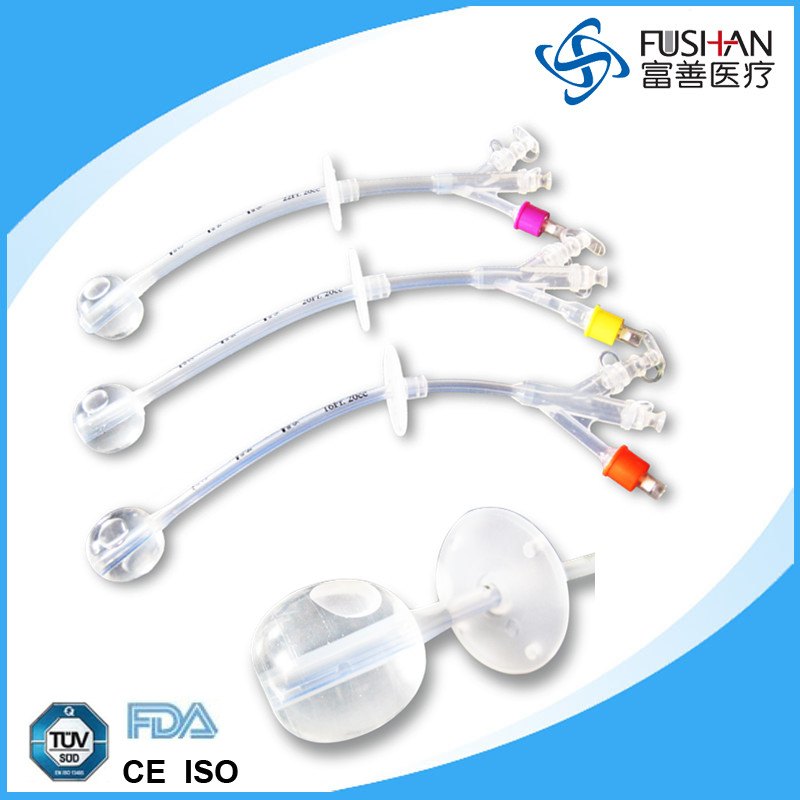James had g-tube surgery at 2 months of age. Surgery was successful, we prepared to be discharged from the hospital after a month, and were so looking forward to taking our child home. James initially had a Mic-Key button but, the night before discharge, something went terribly wrong. We still don't entirely know what happened, but his tube came out. It looked like, somehow, the balloon had slit down the side and, when James' hand knocked against it, it just came out. The nurses did everything right until the surgeon could handle it in the morning, but to no avail. The hole was so new that it was impossible to get the button back in the right place. It was sending liquid into the stomach cavity instead of the stomach itself. Don't worry, this isn't a normal occurrence, just a freak accident I guess. Moral of the story, just check the integrity of the balloon with an external inflation before placing it in the stomach. So, we went back in for emergency surgery. This time, in with a PEG (I believe that is what it was called), instead of a button. Now, a year later, James has a Mini-One button. Here we go:
PEG
This is a PEG, deemed an "old-fashioned" g-tube by our nurses and doctors. Apparently, they are not used often. James received this type after the original button came out as its exit ripped the stomach tissue and this tube has a more secure balloon. The balloon is slightly flatter than the Mic-key's.
Advantages:
1. Security - We, of course, we paranoid about this coming out, but in the six months he had it we didn't have an issue.
2. Ease of use - This one doesn't have a clamp and neither did ours, but I have seen some that do. I liked the lack of clamp as (sometimes) it is just as easy or easier to clamp it by bending the tubing in half. It was also extremely easy to use when out and about because you don't need to worry about attaching a tube extension and it was long enough to fit through the bottom buttons on onesies to keep it away from little hands.
3. Sizing/Cleanliness - This device is all one tube, you just move the circular stopper to the point where it keeps the button close against the stomach wall. This is nice because you don't have to change the tube as your child grows, you just give the tube a little more slack. This also makes the stoma area much easier to clean as you can easily move the stopper to get to the skin.
Disadvantages:
1. Sizing - One MAJOR problem we did have with this tube was the ability to change the length of the tubing. As James began to roll, the tube would get knocked all over the place. One day, while he was playing, the tube must have loosened and the balloon moved farther into his stomach. The balloon ended up lodged in the valve between his stomach and large intestine. This caused mysterious vomiting which sent us to the ER, but was a VERY easy fix as all we had to do was deflate the balloon a bit and pull it back to the right length.
2. Mobility - This tube is not great for more mobile children. It is much more obtrusive than a button. The tubing tends to stick up more than button extensions, making daily activities (tummy time, physical therapy, rolling, etc.) more difficult and uncomfortable.
3. Child's Curiosity - There is a tube there all the time. You, the parent, have to be vigilant about tucking the the tubing away from your child's hands. Bath time can be difficult.
Mic-Key Button
After the balloon-stuck-in-valve incident we elected to get James a button so that the balloon would stay securely against his stomach wall and it would be easier for him to move about. We had a Mic-Key button which we didn't love. Here is what we found:
Advantages:
1. Size - MUCH less obtrusive than the PEG.
2. Tubing - The Mic-Key tubing is detachable, called an "extension." It is wonderful to take this out when James is not eating because it is one less thing for him to pull around and it is less strain on the skin around the tube as there is no tubing to "stretch" it out. Also, he couldn't pull on the g-tube the way he could with the PEG (it was a favorite pastime of his).
Disadvantages:
1. Balloon - We couldn't get James' button to stop leaking. We even filled the balloon more than the recommended size to see if that would help. It didn't. The issue is, the Mic-key balloon is round. That would seem to make sense except, you put a round balloon in a flat hole and you get gaps. This was a huge factor for us in getting rid of the Mic-key.
Mini-One Button
This is the next and final button we chose for James. We love this one! See how the balloon is flatter at the top? No gaps! This button is even small than the Mic-key so take the advantages of the Mic-key, add a smaller button with little or no leaking, and you get a great button! It does have a disadvantage:
Disadvantage:
1. Size - The button is so small that it can be difficult to grasp when inserting the extension or inflating/deflating the balloon. We haven't had any major issues with it and my husband has huge hands, but it could be a deal-breaker for some.
What have you liked/disliked about your specific button? Any suggestions? Feel free to comment!


